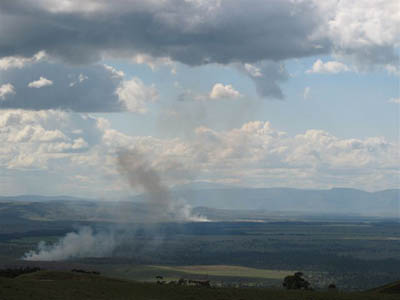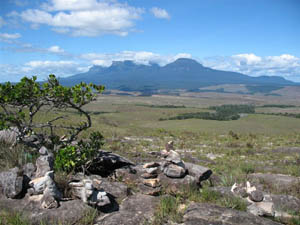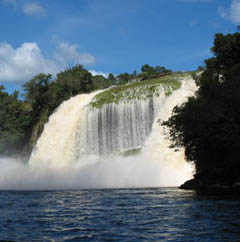The Real Jurassic Park
Canaima National Park, Venezuela
by Sarah Shuckburgh
In a remote corner of Venezuela,
Sarah Shuckburgh discovers a land of unique wildlife, superstitious people - and
thunderous waterfalls.
 There
are only three of us in the Piper – the pilot, my husband
and me. From the co-pilot’s seat, I can’t help noticing that
the cockpit dials are held together with parcel tape and the
needles on the fuel gauges are all on Empty. A tattered
portrait of the Virgin Mary is glued to the altimeter. There
are only three of us in the Piper – the pilot, my husband
and me. From the co-pilot’s seat, I can’t help noticing that
the cockpit dials are held together with parcel tape and the
needles on the fuel gauges are all on Empty. A tattered
portrait of the Virgin Mary is glued to the altimeter.
Our destination is a remote and beautiful corner of
Venezuela, reached, according to official statistics, by
only 3% of the country’s visitors. From Ciudad Bolivar, a
charming old colonial town on the Orinoco river, we are
heading towards a lost world.
With no preamble or safety drill, we rattle along the dirt
runway, and lurch into the air, jerking as if bumping up a
flight of stairs, and then tipping as we wheel over the
scattered remains of a crashed plane, and head out across
bleached grass of the Gran Sabana. A cool breeze blows
through gaping holes in the fuselage. Outside the window,
the plane’s wheels remind me of my lawnmower, and the tyres
have no tread. Both compasses are jammed at north, even
though we are flying south-east. “No worry,” shouts the
pilot, “Very new engine inside.”
 For
a few minutes, I can hear my heart beating with alarm above
the roar of the very-new-engine, but soon I am transfixed by
the views and forget my fear. The savannah stretches to
infinity in all directions - a gently undulating, mottled
carpet of faded green, ochre, khaki and beige, with
occasional swathes of darker tropical forest. Sunlit
clearings are littered with match-stick-thin tree trunks,
slashed by local Indians. We soar over a wide, brick-red
river, and cross smaller tributaries which meander in tight
loops through the forest and swirl out across the plain.
Lines of moriche palms mark the course of underground
streams. Pale webs of narrow footpaths link clusters of
palm-thatched mud huts. The lichen-coloured highlands are
dotted with plumes of smoke, curling into the hazy sky.
Pemón Indians burn the savannah to trap meat - two weeks
later, juicy new shoots will attract tapirs, armadillos and
deer. For
a few minutes, I can hear my heart beating with alarm above
the roar of the very-new-engine, but soon I am transfixed by
the views and forget my fear. The savannah stretches to
infinity in all directions - a gently undulating, mottled
carpet of faded green, ochre, khaki and beige, with
occasional swathes of darker tropical forest. Sunlit
clearings are littered with match-stick-thin tree trunks,
slashed by local Indians. We soar over a wide, brick-red
river, and cross smaller tributaries which meander in tight
loops through the forest and swirl out across the plain.
Lines of moriche palms mark the course of underground
streams. Pale webs of narrow footpaths link clusters of
palm-thatched mud huts. The lichen-coloured highlands are
dotted with plumes of smoke, curling into the hazy sky.
Pemón Indians burn the savannah to trap meat - two weeks
later, juicy new shoots will attract tapirs, armadillos and
deer.
The sky is magical and constantly changing as sun streams
through layers of cloud. We soar above fluffy white cumulus,
bump through banks of menacing grey, and then dip beneath
flat, sausage-shaped clouds as a splatter of rain hits the
windscreen.
After an hour, we reach the tepuys, astonishing rocky
remnants of the time - two billion years ago - when South
America, Africa and Australia were joined. Isolated millions
of years ago from the surrounding plain, the mist-shrouded
summits of these table-mountains are home to unique forms of
life.
 This is Sir Arthur Conan-Doyle’s Lost World. The author
never saw Venezuela’s Gran Sabana with his own eyes, but he
listened to travellers’ tales of this wild and desolate
spot, and described it with uncanny accuracy. We have flown
over his ‘irregular palm-studded plain’, where, in its
‘damper hollows, Mauritia palms threw out their graceful
drooping fronds’, and seen his ‘brooks with pebbly bottoms
and fern-draped banks gurgling down the shallow gorges in
the hill.’ And here is his ‘line of high red cliffs’,
ancient outcrops on whose summits Jurassic flora and fauna
have survived. This is Sir Arthur Conan-Doyle’s Lost World. The author
never saw Venezuela’s Gran Sabana with his own eyes, but he
listened to travellers’ tales of this wild and desolate
spot, and described it with uncanny accuracy. We have flown
over his ‘irregular palm-studded plain’, where, in its
‘damper hollows, Mauritia palms threw out their graceful
drooping fronds’, and seen his ‘brooks with pebbly bottoms
and fern-draped banks gurgling down the shallow gorges in
the hill.’ And here is his ‘line of high red cliffs’,
ancient outcrops on whose summits Jurassic flora and fauna
have survived.
We
land on a bumpy airstrip at Santa Elena, a small mining town
near the Brazilian border, where our guide awaits us. It is
reassuring to have Julio with us- at road blocks, he speaks
deferentially to the armed teenage soldiers as they moodily
check our passports, rip open our luggage, and inscribe our
names in dog-eared ledgers. Julio is also glad to have us,
because with tourists in his car he can avoid a four-hour
queue for petrol. President Chavez has fixed the price of
petrol at a generous 2p per litre, much cheaper than in
neighbouring Brazil, so hundreds of people make a good
living by buying petrol in Santa Elena and selling it across
the border on the black market. Soldiers wielding rifles
supervise mile-long queues of dilapidated vehicles - locals
in one line and Brazilians in another - and collect
unofficial ‘taxes’. Many of the pick-up trucks have been
fitted with huge (illegal) tanks to maximise earnings.

Santa Elena is a jostling, ramshackle frontier town, with
open-fronted shops selling hardware and food, extended
families lounging on doorsteps, tousle-headed prospectors
swigging beer, and a mission church with an unusual wooden
roof, carved by an architect who seduced all Santa Elena’s
maidens before being drummed out of town.
Julio is full of stories. At a riverbank scarred with
illegal gold and diamond open-cast mines, we hear about a
local called Barrabas, who found the world’s largest diamond
and sold it for millions of dollars, only to die as
penniless as he began. Julio explains cheerfully that miners
who find gold often kill team-mates to increase their share
of the haul. Then they spend their earnings on drink.
The
Gran Sabana is as beautiful from the ground as it is from
the air - utterly silent and still, an immense, empty,
sepia-tinted vista scattered with wisps of pale smoke. In
the distance, the craggy tepuys loom, including Roraima, the
highest and most famous, home of Conan-Doyle’s terrifying
dinosaurs. We are attacked by smaller but equally unwelcome
beasts – puri-puri gnats. Our legs are soon covered in red
welts, which itch for days.
 Julio drives us to Quebrada de Jaspe, an orangey-red
riverbed of pure jasper - a radiant, shimmering palace floor
overhung with tangled primary forest. We crouch under a
waterfall for some bracing hydrotherapy, and then tiptoe
gingerly over the slippery slabs. The semi-precious stone
still bears the marks of British prospectors who supplied
luxury bathrooms until 1972, when the area became a national
park. Next, Julio practises his off-road driving skills to
reach Arapena Meru, a frothy cascade of inky, tannin-stained
water, known locally as Coca-Cola falls. Crested caracaras
and vultures wheel overhead in a hot blue sky. At midday, we
reach Woy Meru, a waterfall linking two palm-fringed pools,
where we swim and wallow, and have more head-and-shoulder
massages under the thundering cascade. We lunch on beef,
plantain and yucca in a palm-thatched cabana. Julio drives us to Quebrada de Jaspe, an orangey-red
riverbed of pure jasper - a radiant, shimmering palace floor
overhung with tangled primary forest. We crouch under a
waterfall for some bracing hydrotherapy, and then tiptoe
gingerly over the slippery slabs. The semi-precious stone
still bears the marks of British prospectors who supplied
luxury bathrooms until 1972, when the area became a national
park. Next, Julio practises his off-road driving skills to
reach Arapena Meru, a frothy cascade of inky, tannin-stained
water, known locally as Coca-Cola falls. Crested caracaras
and vultures wheel overhead in a hot blue sky. At midday, we
reach Woy Meru, a waterfall linking two palm-fringed pools,
where we swim and wallow, and have more head-and-shoulder
massages under the thundering cascade. We lunch on beef,
plantain and yucca in a palm-thatched cabana.
Only Indians are permitted to live in the vast Canaima
National Park – its 7.5 million acres make it one of the
largest parks in the world. A new tarmac road linking
Venezuela to Brazil has brought relative prosperity to
villagers who live near it. On the way back to Santa Elena,
we stop at some half-built stalls, buy a palm-woven basket,
and then stroll with Julio through a straggling village.
Beside each new, government-issue concrete bungalow, we see
families sitting in the shade of traditional, open-sided mud
huts thatched with shaggy palm-fronds. Julio explains that
the new corrugated-iron roofs are too hot and stuffy. Children
scamper out to wave at us, but not everyone in the village
welcomes strangers - suddenly we are engulfed in smoke. An
old woman has lit the grass outside her house to purify the
air, and banish our bad magic.
Back on the tarmac road, we pass ancient villagers, bent
double under baskets of dusty manioc. At a river,
brightly-coloured clothes are spread on rocks to dry. We
pick up four park rangers – locals who work as
conservationists and fire-fighters, trying to educate their
peers against burning grass near their homes.
 After two days, we take to the air again, soaring over a
bobbly green mantle of forest spiked with tall palms, sacred
Ceiba trees, and unexpected patches of pink blossom. There
are over a hundred tepuys, some isolated, others separated
by deep, wooded canyons. Waterfalls slice down sheer cliffs
in thin, sparkling ribbons. We skim over grey craggy
summits, deeply fissured with pinnacles and fairytale
battlements, or dotted with patches of coarse grass –
Conan-Doyle’s ‘beautiful fringe of verdure.’ Finally, we
circle over a dramatic labyrinth of eerie gorges, and our
pilot points out Angel Falls, the tallest waterfall in the
world - a slender, glistening thread of water, plunging for
half a mile before dissolving into a cloud of vapour.
Moments later, we reach Canaima, a tiny settlement on a
lagoon, with a row of fat, foaming waterfalls, surrounded by
tangled forest. After two days, we take to the air again, soaring over a
bobbly green mantle of forest spiked with tall palms, sacred
Ceiba trees, and unexpected patches of pink blossom. There
are over a hundred tepuys, some isolated, others separated
by deep, wooded canyons. Waterfalls slice down sheer cliffs
in thin, sparkling ribbons. We skim over grey craggy
summits, deeply fissured with pinnacles and fairytale
battlements, or dotted with patches of coarse grass –
Conan-Doyle’s ‘beautiful fringe of verdure.’ Finally, we
circle over a dramatic labyrinth of eerie gorges, and our
pilot points out Angel Falls, the tallest waterfall in the
world - a slender, glistening thread of water, plunging for
half a mile before dissolving into a cloud of vapour.
Moments later, we reach Canaima, a tiny settlement on a
lagoon, with a row of fat, foaming waterfalls, surrounded by
tangled forest.
The next morning, we wake in time to see the sun rise beyond
the waterfalls. We swim in the silky saponin-dark lake,
fringed with freshwater mangroves, moriche palms and dense
jungle. There are no roads to Canaima and the sense of peace
is intense. We could have spent the day journeying in a
dugout canoe to the foot of the Angel Falls, but instead we
loll in palm-fibre hammocks, soothed by the roar of the
falls and caressed by cool spray which wafts across the
lake. Macaws and toucans, in unlikely, gaudy colours, strut
past our veranda. Monkeys chuckle from a large cage. In the
afternoon, the skies turn stormy and then radiantly pink.
At dusk, we stroll along a beach of soft, pink sand and
watch village children splash in the terracotta-coloured
shallows. Mothers, sitting at the water’s edge, pause from
their laundry to gaze out across the inky ripples of the
lagoon. As darkness falls, fireflies flash from the jungle,
frogs croak, macaws screech, cicadas chirp, bats swoop and
the inky sky is covered with stars. And the waterfalls
thunder on.
First published by the Telegraph
©SarahShuckburgh |